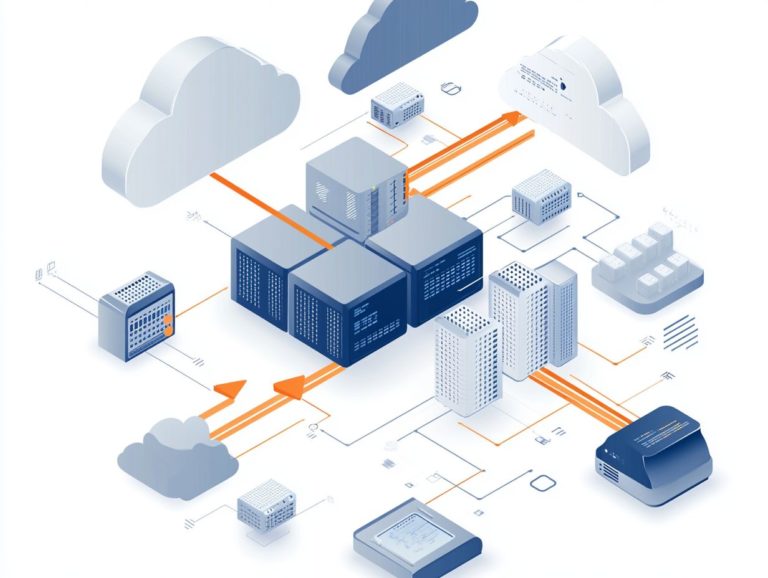How to Measure IaaS ROI
In today s fast-paced digital landscape, grasping the return on investment (ROI) for Infrastructure as a Service (IaaS) is essential if you want to optimize your cloud strategies.
This article unpacks the fundamentals of IaaS, emphasizing why measuring its ROI is important and highlighting the key factors that influence it such as costs, efficiency, and productivity.
You ll be guided through the ROI calculation process and provided with strategies to maximize your returns while tackling common measurement challenges.
Jump in and discover how you can make smart decisions that will drive your business ahead!
Contents
Key Takeaways:

Understand the basics of IaaS and why measuring ROI is important for businesses.
Consider factors such as costs, efficiency, and productivity when calculating IaaS ROI.
Explore strategies for maximizing IaaS ROI, including how to optimize IaaS for cost efficiency, and understand potential challenges and limitations in measuring ROI.
Understanding IaaS ROI
Understanding the return on investment (ROI) of Infrastructure as a Service (IaaS) is essential as you strive to maximize your technology investments and foster sustainable business growth. For deeper insights, explore the impact of cloud costs on ROI.
IaaS offers scalable cloud computing resources that can be customized to suit your diverse operational needs.
This delivers considerable financial advantages when evaluated and employed effectively.
By calculating your software ROI, you can assess the total cost of ownership, including both setup costs and ongoing expenses.
This comprehensive analysis will ultimately bolster your cloud strategy, enhancing efficiency and productivity across your organization.
What is IaaS?
Infrastructure as a Service (IaaS) is a game-changing cloud computing model that enables you to access virtualized computing resources over the internet, which enables your business to utilize robust infrastructure without the hefty price tag of physical hardware.
This model enhances scalability, allowing you to seamlessly adjust your resources in response to shifting demands.
It also provides remarkable flexibility, supporting a variety of operating systems and applications tailored to your needs.
With IaaS, you re liberated from the limitations of traditional hardware.
This accelerates deployments and eases the load on your IT teams.
Leading cloud providers like Amazon Web Services, Microsoft Azure, and Google Cloud Platform offer powerful IaaS solutions specifically designed to meet your diverse operational requirements.
Why Measure ROI?
Measuring ROI is crucial for evaluating the effectiveness of your cloud and software investments.
It provides actionable insights into your financial performance and operational efficiency.
With a clear understanding of financial metrics, you can make informed decisions that align with your strategic goals.
This approach not only enhances your resource allocation but also improves customer satisfaction, as you become skilled at identifying the technologies that deliver the highest returns.
When you optimize financial performance, you re likely to see a boost in employee productivity, as they gain access to tools that streamline processes and eliminate unnecessary complexities.
A comprehensive approach to measuring cloud and software ROI is key to achieving sustainable growth.
Factors Affecting IaaS ROI
Several key factors profoundly influence the return on investment (ROI) of Infrastructure as a Service (IaaS).
These elements shape not only the costs you incur but also the potential savings you can realize over time.
Costs and Savings

When evaluating IaaS ROI, grasp both implementation costs and ongoing subscription fees. Understanding these costs helps you determine total ownership expenses and highlights potential savings.
Your assessment should include various factors such as development costs, maintenance, and support services. These elements significantly influence your operational business needs.
As you embrace Infrastructure as a Service, account for expenses related to migrating existing applications, training staff, and ensuring robust security measures are firmly in place. These considerations shape your overall budgetary strategies.
Effective IaaS deployments can lead to significant long-term savings through reduced capital expenditures and enhanced operational efficiency.
Efficiency and Productivity
Improving efficiency and productivity is essential for maximizing your IaaS ROI. By optimizing internal business processes, you can enhance employee engagement and accelerate project delivery.
When developing apps for the cloud, streamline workflows and automate repetitive tasks. This significantly cuts down the time your team spends on mundane activities, creating a more engaging work environment that allows teams to focus on innovation and strategic initiatives.
For example, tracking metrics like deployment frequency and mean time to recovery provides a clear view of operational efficiency. These insights help identify bottlenecks, ensuring resources are allocated effectively and projects are delivered swiftly without compromising quality.
Calculating IaaS ROI
Calculating the Return on Investment (ROI) for Infrastructure as a Service (IaaS) requires a meticulous approach that combines financial metrics, expenditure tracking, and a thorough assessment of anticipated returns. To effectively measure this, understanding key metrics to evaluate IaaS performance is essential. This method shows how your investments perform and helps you make informed decisions.
ROI Formula and Metrics
Use this simple ROI formula: (Net Profit / Total Investment) x 100. This allows you to evaluate your estimated returns with precision.
This formula serves as a vital benchmark for decision-makers assessing the viability and financial performance of cloud infrastructure investments. Track financial metrics to gain insights into your ROI, including operational cost savings from increased efficiency and reduced downtime.
Don t forget variables like increased revenue from enhanced capabilities or improved customer satisfaction. Accurately estimating these elements directly influences the perceived value of your IaaS investments, enabling informed strategic choices.
Maximizing IaaS ROI
Unlock the full potential of your IaaS ROI today! A strategic approach prioritizes enhancing software performance and optimizing internal processes. Embrace best practices for cloud environments to maximize your investment.
Strategies for Improving ROI

Boost your IaaS ROI now by adopting effective strategies that leverage financial advantages, improve customer retention, and automate tasks through cloud development.
Regularly evaluate your costs and identify areas for enhanced efficiency. Deploy automation tools to streamline operations and significantly reduce manual workloads.
This approach cuts costs and minimizes the risk of human error an important consideration for any business.
Integrating robust customer relationship management systems allows you to gain deeper insights into client needs and preferences. With this knowledge, tailor your services effectively.
Ultimately, this fosters improved satisfaction and loyalty, translating into a stronger return on investment over time.
Challenges and Limitations of Measuring IaaS ROI
Measuring the ROI of IaaS can present a host of challenges and limitations that may obstruct your ability to conduct accurate assessments. These complexities can complicate well-considered choices regarding technology investments.
It’s essential to navigate these challenges thoughtfully. Doing so ensures that your evaluations lead to sound strategic choices.
Common Obstacles and How to Overcome Them
Common obstacles in measuring IaaS ROI often stem from inadequate tracking of financial metrics and a lack of employee engagement in the evaluation process. Fortunately, these hurdles can be addressed through a more effective cloud strategy.
The challenge amplifies if an organization fails to align its financial tracking methods with specific IaaS-related goals. Teams can easily overlook key performance indicators, resulting in evaluations that miss the mark and fail to capture true value.
To overcome these issues, consider establishing robust tracking frameworks that actively incorporate direct feedback from team members. This approach fosters a sense of ownership and responsibility among employees. Engaging them in conversations about IaaS outcomes provides valuable insights that enhance decision-making.
Ultimately, this ensures that the cloud solutions you adopt are not just cost-effective but genuinely beneficial to your operational needs.
Frequently Asked Questions
What is IaaS ROI and why is it important to measure?
IaaS, or Infrastructure as a Service, provides virtual computing resources via the internet. Measuring IaaS ROI is crucial! It helps you grasp the true value of your investment and make informed decisions about future investments.
What factors should be considered when measuring IaaS ROI?

When measuring IaaS ROI, take into account several factors. These include the initial cost of investment, ongoing operational costs, cost savings compared to traditional infrastructure, and the impact of IaaS on business processes and productivity. To effectively manage these aspects, consider reviewing a detailed guide on how to plan your IaaS budget.
How can I calculate IaaS ROI?
Calculating IaaS ROI involves comparing initial investment costs to expected benefits over a specific period. For a deeper understanding of these calculations, including how to measure ROI for your SaaS investment, subtract the initial investment costs from the total benefits and divide the result by the initial investment costs. The resulting percentage represents the IaaS ROI.
What are some common challenges when measuring IaaS ROI?
One of the most common challenges is determining the appropriate timeframe to analyze. IaaS ROI can vary over time, so it’s important to choose a timeframe that accurately reflects the benefits and costs of the investment.
Identifying and quantifying all costs and benefits is also a challenge.
What are some potential benefits of a high IaaS ROI?
A high IaaS ROI indicates that the investment has been successful and has generated significant returns. This can lead to numerous benefits, such as cost savings, increased efficiency and productivity, improved scalability, and the ability to invest in other areas of the business.
What Steps Can You Take to Boost Your IaaS ROI?
To improve your IaaS ROI, consider optimizing your usage and resource allocation. Negotiate better pricing with your IaaS provider and continuously evaluate and adjust your strategy to align with your business goals.
Regularly monitoring and tracking your ROI will help you identify areas for improvement.
Don’t wait! Start developing a plan for measuring your IaaS ROI today to unlock its full potential!






